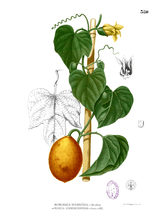Gac
| Gac | |
|---|---|
| | |
| Exterior and cross-sectional interior of gac | |
| Rare (NCA) | |
| Scientific classification | |
| Kingdom: | Plantae |
| (unranked): | Angiosperms |
| (unranked): | Eudicots |
| (unranked): | Rosids |
| Order: | Cucurbitales |
| Family: | Cucurbitaceae |
| Genus: | Momordica |
| Species: | M. cochinchinensis |
| Binomial name | |
| Momordica cochinchinensis (Lour.) Spreng. | |
Gac is a fruit produced by Momordica cochinchinensis, which is found throughout the Southeast Asian region from South China to Northeastern Australia, including Thailand, Laos, Myanmar, Cambodia and Vietnam.
Etymology
It is commonly known as gac from the Vietnamese gấc (pronounced [ɣək˦˥]) or quả gấc (quả being a classifier for spherical objects such as fruit). It is known as mùbiēguǒ in Chinese and variously as red melon, baby jackfruit, spiny bitter gourd or cochinchin gourd in English. In Thai, it is pronounced fahk khao and taw thabu in Myanmar.
Characteristics

Because it has a relatively short harvest season (which peaks in December and January), making it less abundant than other foods, gac is typically served at ceremonial or festive occasions in Vietnam, such as Tết (the Vietnamese new year) and weddings. It is most commonly prepared as a dish called xôi gấc, in which the aril and seeds of the fruit are cooked in glutinous rice, imparting both their color and flavor. More recently, the fruit has begun to be marketed outside of Asia in the form of juice dietary supplements because of its high phytonutrient content.
Growth
Gac grows on dioecious vines and is usually collected from fence climbers or from wild plants. The vines can be commonly seen growing on lattices at the entrances to rural homes or in gardens. It only fruits once a year, and is found seasonally in local markets. The fruit itself becomes a dark orange color upon ripening, and is typically round or oblong, maturing to a size of about 13 cm in length and 10 cm in diameter. Its exterior skin is covered in small spines while its dark red interior consists of clusters of fleshy pulp and seeds.
Traditional uses
Traditionally, gac has been used as both food and medicine in the regions in which it grows. Other than the use of its fruit and leaves for special Vietnamese culinary dishes, gac is also used for its medicinal and nutritional properties. In Vietnam, the seed membranes are said to aid in the relief of dry eyes, as well as to promote healthy vision. Similarly, in traditional Chinese medicine the seeds of gac, known in Mandarin Chinese as mù biē zǐ (Chinese: 木 鳖 子 meaning 'wooden turtle seed'[1]), are employed for a variety of internal and external purposes.
Nutrients and phytochemicals
Typical of orange-colored plant foods, gac fruit contains carotenoids such as beta-carotene (provitamin A).[2] Vietnamese children fed a rice dish containing beta-carotene from gac had higher blood levels of beta-carotene than those in the control group.[3] Gac aril oil contains high levels of vitamin E.[4] Fatty acids in the aril oil may facilitate absorption of fat-soluble nutrients, including carotenoids.[5]
Due to its high content of beta-carotene and lycopene,[2][5][6] gac extracts may be sold as a food supplement in soft capsules or included in a juice blend.
Notes
- ↑ "Momordica cochinchinensis". Retrieved 3 December 2015.
- 1 2 Ishida BK, Turner C, Chapman MH, McKeon TA (2004). "Fatty Acid and Carotenoid Composition of Gac (Momordica cochinchinensis Spreng) Fruit". J. Agric. Food Chem. 52 (2): 274–9. doi:10.1021/jf030616i. PMID 14733508.
- ↑ Vuong LT, Dueker SR, Murphy SP (2002). "Plasma β-Carotene and Retinol Concentrations of Children Increase After a 30-d Supplementation with the Fruit Momordica cochinchinensis (Gac)". Am. J. Clin. Nutr. 75 (5): 872–9. PMID 11976161. Retrieved 5 January 2013.
- ↑ Kuhnlein HV (2004). "Karat, Pulque, and Gac: Three Shining Stars in the Traditional Food Galaxy". Nutr. Rev. 62 (11): 439–42. doi:10.1111/j.1753-4887.2004.tb00015.x. PMID 15622716.
- 1 2 Burke DS, Smidt CR, Vuong LT (2005). "Momordica cochinchinensis, Rosa roxburghii, Wolfberry, and Sea Buckthorn - Highly Nutritional Fruits Supported by Tradition and Science" (PDF). Current Topics in Nutraceutical Research. 3 (4): 259–66.
- ↑ Phan-Thi, H.; Waché. Y. (2014). "Isomerization and increase in the antioxidant properties of lycopene from Momordica cochinchinensis (gac) by moderate heat treatment with UV–Vis spectra as a marker". Food Chemistry. 156 (1): 58–63. doi:10.1016/j.foodchem.2014.01.040.
External links
 Media related to Momordica cochinchinensis at Wikimedia Commons
Media related to Momordica cochinchinensis at Wikimedia Commons